Abstract 
Colonialism did not merely subjugate land and economies; it reorganised consciousness itself. In Punjab, British colonial administration reframed Guru Nanak Sahib’s ontological revelation — a science of consciousness grounded in Naam, Hukam, and the deconstruction of ego (haumai) — into the category of “Sikhism,” a world religion defined by belief, ritual, and external identity. The mystical orientation of Gurmat was translated into theological language: Naam reduced to the “Name of God,” Simran to “prayer,” and Ik Onkaar to “One God.” Through census, legislation, missionary discourse, and colonial education, an ontological path of Being was reconstructed as a belief-based religion.
This article demonstrates how colonial categories imposed a reductionist, religious worldview that contradicts Guru Nanak’s teaching. Where Gurbani dismantles identity and haumai, colonial frameworks enforced rigid identities and externalised worship. The result was a profound conditioning of Sikhs to interpret their own tradition through foreign categories — a form of cognitive colonisation.
By returning to Gurbani’s ontological foundations and integrating insights from consciousness studies, neuroscience, and psychospiritual health, this article proposes a decolonial recovery of Gurmat meditation. Naam is understood here as the ontological vibration of Being itself, and Simran as continuous alignment of consciousness with that resonance. Gurmat Therapy represents this recovery: an evidence-based, experiential framework that re-establishes meditation as medicine for body, mind, and soul, and restores Guru Nanak’s gift as a timeless science of consciousness for humanity.
Introduction
Colonialism and the Reframing of Gurmat 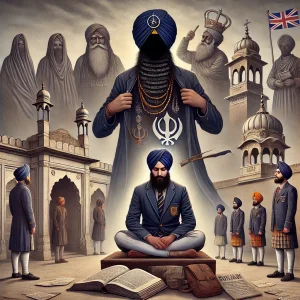
The encounter between British colonial administration and Punjab was not only a political conquest; it was an epistemic restructuring. To govern populations, the British categorised Indians into “world religions” — Hinduism, Islam, Sikhism — each to be managed as a community with fixed boundaries, scriptures, and rituals. Gurmat, the ontological revelation of Guru Nanak Sahib, was thus reframed into “Sikhism,” a religion comparable to Christianity and Islam.
This reframing distorted the essence of Guru Nanak’s teaching. Guru Nanak did not establish a new religion. He disclosed an ontological reality: that Being is vibration (Naam), that existence flows according to Hukam, that ego (haumai) is illusion, and that liberation (mukti) is realised in dissolving self into Naam. His proclamation of Ik Onkaar was not theological monotheism, but ontological non-duality: the One Vibration that pervades and sustains all.
Yet colonial translations and categories reduced this science of consciousness into a belief-system. Naam was rendered as “the Name of God,” shifting from ontological resonance to theological label. Simran, the attunement of consciousness to Naam, was mistranslated as prayer — an externalised petition to a deity. Ik Onkaar became “One God,” aligning Guru Nanak with Western monotheism. This transformation was not neutral; it was part of a larger project of epistemic control.
From Being to Belief
The shift can be summarised as a movement from Being to belief. In Gurmat, Naam is not an object of belief but the very vibration of Being. Simran is not a prayer directed outward, but continuous remembrance that aligns consciousness with Being. Hukam is not a command of an external lawgiver but the ontological order of reality. To reduce these to belief categories is to misrepresent them fundamentally.
Guru Nanak’s Japji Sahib makes this explicit:
“ਹੁਕਮੀ ਹੋਵਨਿ ਆਕਾਰ ਹੁਕਮੁ ਨ ਕਹਿਆ ਜਾਈ ॥
ਹੁਕਮੀ ਹੋਵਨਿ ਜੀਅ ਹੁਕਮਿ ਮਿਲੈ ਵਡਿਆਈ ॥”
Hukmī hovan ākār hukam na kahi▫ā jā▫ī.
Hukmī hovan jī▫a hukam milai vadi▫ā▫ī.
“By Hukam forms arise; Hukam cannot be spoken.
By Hukam beings are born; by Hukam greatness is obtained.” (Japji Sahib, SGGS Ang 1)
Here Hukam is described as the ontological ordering principle of reality, beyond conceptualisation, not a decree of an external deity. Yet colonial translations routinely rendered Hukam as “command,” distorting ontology into theology.
The Brainwashing of Conditioning
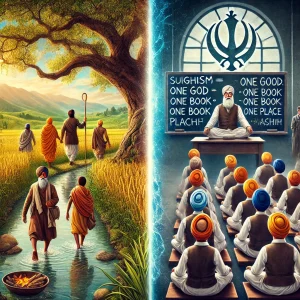
Through the census, the Singh Sabha reforms, missionary writings, and colonial education, generations were conditioned to see themselves as adherents of a religion rather than participants in a mystical ontology. Sikh children were taught catechism-like formulations: Sikhs believe in one God, Sikhs have one scripture, Sikhs worship in Gurdwaras. What was once lived mystical orientation became fixed identity and external worship.
This can rightly be called a form of cognitive colonisation. By reframing terms and categories, colonial discourse “brainwashed” communities into interpreting their own tradition through Western categories of “religion,” “worship,” and “identity.” The internalisation of these categories persists today, when Simran is often presented as prayer, Naam as “God’s Name,” and Gurbani as scripture rather than Shabad (vibration of Being).
Contrary to Guru Nanak’s Teaching
Such distortions are directly opposed to Guru Nanak’s teaching. Guru Nanak relentlessly deconstructed identity and haumai. He rejected caste, creed, and ritual identity. His ontology undermines precisely what colonialism enforced: rigid identity categories. Gurbani is emphatic:
“ਹਉਮੈ ਵਿਚਿ ਜਗਤੁ ਮੁਆ ਮਰਿ ਜਨਮੈ ਆਵੈ ਜਾਇ ॥
ਗੁਰਮੁਖਿ ਹਉਮੈ ਖੋਈਐ ਤਾ ਸਚਾ ਨਾਮੁ ਸਮਾਇ ॥”
Ha▫umai vicẖ jagaṯ mu▫ā mar janmai āvai jā▫e.
Gurmukẖ ha▫umai kẖo▫ī▫ai ṯā sacẖā nām samā▫e.
“In ego, the world dies and is reborn, coming and going.
As Gurmukh, ego is dissolved, and one merges in Naam.” (SGGS Ang 560)
Where Guru Nanak dismantled egoic identity, colonialism reinforced it. Where Guru Nanak revealed Being, colonialism imposed belief. Where Guru Nanak centred Simran as ontological remembrance, colonialism reframed it as worship and prayer. The two stand in direct opposition.
Purpose of this Article
This article has three objectives:
- To articulate the ontological foundations of Guru Nanak’s teaching, particularly Naam, Hukam, Simran, and the critique of haumai.
- To demonstrate how colonial frameworks distorted these foundations into categories of belief, worship, and identity.
- To propose decolonisation of meditation through Gurmat Therapy — a framework that integrates Gurbani ontology with contemporary science, restoring meditation as medicine for mind, body, and soul, and reclaiming Guru Nanak’s gift as a science of consciousness.
- Ontological Foundations of Guru Nanak’s Teaching
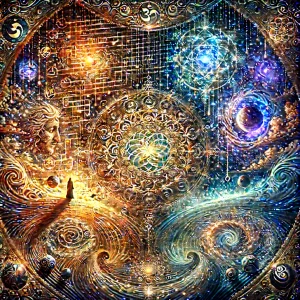
2.1 Ik Onkaar: Ontology, not Theology
The opening of Japji Sahib establishes Guru Nanak’s paradigm not as religion but as ontology:
“ੴ ਸਤਿ ਨਾਮੁ ਕਰਤਾ ਪੁਰਖੁ ਨਿਰਭਉ ਨਿਰਵੈਰੁ ਅਕਾਲ ਮੂਰਤਿ ਅਜੂਨੀ ਸੈਭੰ ਗੁਰ ਪ੍ਰਸਾਦਿ ॥”
Ik·oaṅkār sat nām kartā purakh nirbhau nirvair akāl mūrat ajūnī saibhaṅ gur parsād.
“One reality — the vibration of Being, whose Name is Truth, the Creative Presence, fearless, without enmity, timeless, unborn, self-existent, realised through grace.” (Japji Sahib, SGGS Ang 1)
Colonial frameworks translated this into “There is One God,” placing Guru Nanak within Western monotheism. Yet the grammar and context of Gurbani reveal a very different orientation. Ik Onkaar is not a theological “God” but an ontological vibration — the oneness of Being itself. Sat Naam is not “the true name of God,” but Truth as ontological resonance. Kartā Purakh is not a creator deity, but creative Being permeating all.
Thus, the very opening of Gurbani resists theological categories. It is an experiential proclamation: reality is One Vibration, infinite, self-sustaining. This sets the stage for meditation as alignment with Being, not worship of a deity.
2.2 Naam: Ontological Vibration of Being
Naam is central in Gurbani, yet one of the most distorted concepts. Colonial translators rendered Naam as “the Name of God,” shifting it into linguistic or devotional meaning. In truth, Naam refers to the vibration of Being itself — the ontological resonance through which all forms arise and return.
Guru Arjan Dev Ji explains:
“ਹਰਿ ਕਾ ਨਾਮੁ ਅਉਖਧੁ ਮੁਖਿ ਪਾਈਐ ਤਾ ਸਰਬ ਰੋਗ ਕਾ ਨਾਸੁ ॥”
Har kā nām a·ukẖaḏẖ mukẖ pā·ī·ai tā sarab rog kā nās.
“The Naam is medicine; when it dwells on the lips, all disease departs.” (SGGS Ang 184)
Here, Naam is described not as belief or recitation but as medicine — ontological healing force that dissolves disease at every level: mental, emotional, physical, transpersonal. It is medicine because it realigns consciousness with Being, dissolving dissonance (dukh).
Similarly, Guru Nanak Sahib proclaims:
“ਸਤਿ ਨਾਮੁ ਕਰਤਾ ਪੁਰਖੁ …”
The ontological Naam itself is the essence of Being (Japji Sahib, SGGS Ang 1).
Thus, Naam is not symbolic. It is the very vibration that sustains existence. Meditation in Gurmat is therefore not repetition of a divine name but alignment of surat (attention) with this vibration.
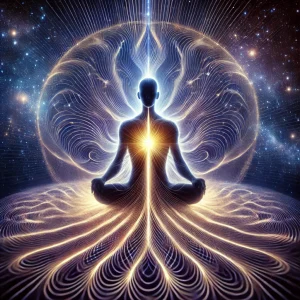
2.3 Simran: Ontological Remembrance
If Naam is Being, Simran is the practice of dwelling in it. Colonial categories reframed Simran as “prayer,” but in Gurmat, Simran is not petition. It is ontological remembrance — continuous attunement of consciousness to Naam.
Guru Nanak Sahib in Japji Sahib:
“ਸਤਿ ਨਾਮੁ ਸਿਮਰਹੁ ਮਨ ਮੇਰੇ ॥”
Sat nām simrahu man mere.
“O my mind, dwell in remembrance of the True Naam.” (SGGS Ang 262)
Simran is remembering reality as it is, aligning breath and attention with Naam. Over time, Simran becomes ajappa jap — remembrance without effort, like heartbeat.
Guru Arjan Dev Ji confirms:
“ਸਿਮਰਿ ਸਿਮਰਿ ਸੁਖੁ ਪਾਇਆ ਜਨਮ ਮਰਣ ਦੁਖੁ ਲਾਥਾ ॥”
Simir simir sukẖ pā·i·ā janam maraṇ dukh lāthā.
“Through Simran, peace is obtained; the pains of birth and death depart.” (SGGS Ang 201)
Thus, Simran is not directed outward but inward, dissolving ego and fear of death, aligning consciousness with eternal Being.
2.4 Hukam: Ontological Order
A cornerstone of Guru Nanak’s ontology is Hukam. Colonial translations often render Hukam as “command,” implying an external ruler issuing decrees. Gurbani reveals Hukam as the ontological order of reality — the flow through which existence manifests.
Guru Nanak Sahib states in Japji Sahib:
“ਹੁਕਮੀ ਹੋਵਨਿ ਆਕਾਰ ਹੁਕਮੁ ਨ ਕਹਿਆ ਜਾਈ ॥”
Hukmī hovan ākār hukam na kahi·ā jā·ī.
“By Hukam forms arise; Hukam cannot be spoken.” (Japji Sahib, SGGS Ang 1)
Hukam is ineffable, not conceptual. It is the ordering principle of Being, not external law. Meditation aligns the individual consciousness with Hukam, dissolving resistance and ego.
Thus, health, liberation, and peace are found not in controlling life but in flowing with Hukam.
2.5 Haumai: Ego as Ontological Distortion
Guru Nanak identified haumai (egoic “I am-ness”) as the root of dissonance. Haumai is not mere pride but the ontological illusion of separateness from Naam. It is the false self that clings to identity, categories, and control.
Guru Amar Das Ji:
“ਹਉਮੈ ਵਿਚਿ ਜਗਤੁ ਮੁਆ ਮਰਿ ਜਨਮੈ ਆਵੈ ਜਾਇ ॥ ਗੁਰਮੁਖਿ ਹਉਮੈ ਖੋਈਐ ਤਾ ਸਚਾ ਨਾਮੁ ਸਮਾਇ ॥”
“In haumai the world dies and is reborn, coming and going.
As Gurmukh, ego is dissolved, and one merges in Naam.” (SGGS Ang 560)
Thus, haumai creates cycles of suffering (janam maran), while dissolution of ego through Naam brings liberation.
Colonial identity frameworks reinforced haumai by conditioning Sikhs into rigid labels — precisely what Guru Nanak dismantled.
2.6 Gurmukh vs Manmukh
Gurbani consistently contrasts two orientations:
- Manmukh — ego-facing, oriented toward mind and maya.
- Gurmukh — Guru-facing, aligned with awareness, Presence, Naam and Hukam.
Guru Nanak Sahib in Japji Sahib:
“ਮੰਨੈ ਸੁਰਤਿ ਹੋਵੈ ਮਨਿ ਬੁਧਿ ॥ ਮੰਨੈ ਸਗਲ ਭਵਣ ਕੀ ਸੁਧਿ ॥”
Mannai suraṯ hovai man buḏẖ. Mannai sagal bhavaṇ kī suḏẖ.
“By attunement, awareness and wisdom arise; by attunement, one comes to know all realms.” (Japji Sahib, SGGS Ang 3)
Becoming Gurmukh is the fruit of meditation: shifting from egoic identity to ontological alignment. Colonialism’s insistence on “Sikh identity” as external markers represents manmukh orientation — egoic fixation — whereas Guru Nanak pointed toward gurmukh orientation, dissolving self into Being.
Conclusion to Section 2
The ontological foundations of Guru Nanak’s teaching are clear:
Ik Onkaar → Consciousness as ground of reality; One Vibration, not “One God.”
Naam → Resonance of Being, presence itself, medicine of coherence.
Simran → Ontological remembrance, attunement of consciousness into Naam.
Hukam → Alignment with presence, order of Being, not command.
Haumai → Egoic disruption of resonance, root of fragmentation.
Gurmukh → Embodiment of alignment; living consciousness harmonised with Being.
Colonialism distorted each of these: from vibration to deity, from remembrance to prayer, from Hukam to command, from deconstruction of ego to imposition of identity. This is the heart of epistemic colonisation.
Decolonising meditation begins here: reclaiming these terms in their ontological depth, and living them as Guru Nanak revealed
- Colonialism and the Reductionist Reframing of Gurmat
3.1 Colonialism as Epistemic Conquest
The British colonisation of Punjab in 1849 was not only a military and political event; it was an epistemic conquest. Colonial administrators sought to categorise, classify, and control the population through rigid categories of religion, caste, and identity. To govern effectively, they required definitions: who is Hindu, who is Muslim, who is Sikh.
In this process, Gurmat — the ontological revelation of Guru Nanak Sahib — was reframed into “Sikhism,” a “world religion” comparable to Christianity and Islam. Its dynamic mystical practice was frozen into rigid identity markers and doctrinal boundaries.
This reframing imposed an alien worldview. Where Guru Nanak’s ontology dissolved boundaries, colonialism erected them. Where Guru Nanak emphasised Being, colonialism insisted on belief. Where Guru Nanak dismantled haumai (egoic identity), colonialism reinforced identity.
3.2 The Construction of “Sikhism”
The term “Sikhism” itself is a colonial construct. In Punjabi, there is only Gurmat (“the path of the Guru’s wisdom”) or Sikhi (the lived orientation of a learner). The suffix “-ism” reflects a Western taxonomy of “world religions.” By naming it “Sikhism,” colonial discourse reframed Gurmat into a religion with boundaries, scripture, clergy, and rituals.
Max Arthur Macauliffe, a colonial administrator and missionary-turned-scholar, explicitly translated Gurbani in terms of Christianity. Ik Onkaar became “One God,” aligning Guru Nanak with Christian monotheism. Naam became “Name of God,” reducing ontological vibration to linguistic label. Simran became “prayer,” an act of worship rather than remembrance of Being. Hukam was rendered “command,” a decree from a lawgiver.
Each of these mistranslations reframed Guru Nanak’s ontology into theology, fitting Gurmat into categories legible to the colonial mind.
3.3 Census, Law, and Identity Enforcement
Colonial governance required fixed identities. The decennial census forced Punjabis to identify as Hindu, Muslim, or Sikh. Fluid practices — where one might sing bhajans in the morning and listen to qawwals in the evening — were no longer possible within colonial categories. One had to declare a single identity.
The Punjab Laws Act and later the Sikh Gurdwaras Act (1925) codified Sikh institutions within legal frameworks. Authority was centralised, ritual was standardised, and external identity markers (kesh, turban) became legally enforced. These moves transformed a mystical lifestyle into a regulated religion.
What had once been Guru Nanak’s deconstruction of labels — his refusal of caste, creed, and religious identity — was now inverted. Sikhs were defined by external identity, precisely what Guru Nanak dismantled.
 3.4 Missionary Translations and Educational Brainwashing
3.4 Missionary Translations and Educational Brainwashing
Colonial education entrenched these distortions. Textbooks for Sikh children described their tradition as a religion with doctrines and practices, mirroring Christian catechisms: Sikhs believe in one God, Sikhs have one holy book, Sikhs worship in Gurdwaras.
This was a profound distortion. Gurbani does not ask for belief but for direct attunement to Being. The Guru Granth Sahib is not a book of doctrine but the living Shabad, resonance of consciousness. The Gurdwara is not a place of worship but a locus of Sangat, collective resonance in Naam.
Through repeated schooling, these distortions became internalised. Generations of Sikhs came to understand themselves not as practitioners of an ontological science but as members of a religion defined by belief. This was cognitive colonisation — a “brainwashing” into categories foreign to Guru Nanak’s teaching.
3.5 Singh Sabha and the Internalisation of Colonial Categories
The Singh Sabha movement (late 19th–early 20th century) arose as a response to missionary critique and colonial categories. While it sought to revive Sikh distinctiveness, it did so largely within the colonial framework of religion. It emphasised boundaries, codified rituals, and redefined Sikh identity in terms of externals.
This movement, though important for survival under colonial scrutiny, inadvertently reinforced the reductionist reframing of Gurmat. In aligning itself with the colonial idea of religion, it deepened the loss of ontology.
3.6 Ontological Concepts Distorted 
Let us briefly trace how the key ontological terms were reframed:
- Ik Onkaar: Ontological oneness of consciousness → translated as “One God.”
- Naam: Resonance of Being, medicine of presence → reduced to “Name of God.”
- Simran: Ontological remembrance, alignment of consciousness → reduced to “prayer. “rememebing””
- Hukam: Order of Being, alignment in presence → mistranslated as “command.”
- Haumai: Ontological distortion of ego-identity → ignored, while colonial frameworks reinforced identity.
This was not a simple mistranslation but a structural reorganisation of consciousness. Ontology was reduced to theology; presence was externalised into worship; identity was reified.
3.7 Consequences of Colonial Reframing
The impact of this reductionism has been profound:
- Psychological: Sikhs learned to interpret their practice as belief rather than Being, creating dissonance between ontology and conditioned self-understanding.
- Spiritual: Mystical practice of Simran was replaced by ritual repetition and external prayer, weakening experiential depth.
- Cultural: Identity became externalised, focused on markers and legal definitions, contrary to Guru Nanak’s dismantling of labels.
- Epistemic: Generations were conditioned to see Gurmat through colonial categories, forgetting the ontological roots.
This represents not only distortion but inversion: Guru Nanak dismantled haumai, while colonialism reinforced it through identity. Guru Nanak dissolved boundaries, while colonialism imposed them. Guru Nanak revealed Being, while colonialism reduced it to belief.
Conclusion to Section 3
Colonialism reframed Gurmat from ontology to religion. Through translations, law, census, and education, it imposed a reductionist worldview that continues to shape Sikh self-understanding today. The ontological resonance of Naam became “God’s Name,” Simran became prayer, Hukam became command, and fluid mystical practice became rigid identity.
This was not only a political strategy but an epistemic conquest — a brainwashing into categories foreign to Guru Nanak’s teaching. The result is a contradiction: the very structures meant to preserve Sikh distinctiveness under colonialism entrenched distortions that are alien to Guru Nanak’s revelation.
Decolonising meditation requires exposing these distortions and returning to the ontology of Gurbani: Naam as resonance of Being, Simran as remembrance of presence, Hukam as alignment with reality, and Gurmukh as the dissolution of identity into consciousness.
4.0 The Imposition of Judeo-Christian Terms and the Loss of Ontology
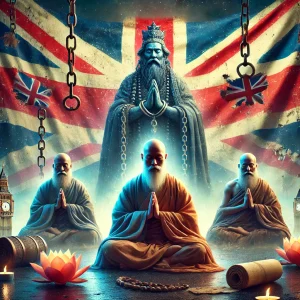
4.1. Colonial Translation as Epistemic Violence
When the British began to document and translate Sikh texts in the nineteenth century, they did so through the lens of Judeo-Christian theology. Words that had deep ontological meaning in Gurbani were reinterpreted through Christian categories of God, worship, prayer, and command. This was not merely a linguistic error but an epistemic restructuring, reducing Guru Nanak’s science of consciousness into a religion that fit Western frameworks.
4.2. Ik Onkaar → “One God”
- Ontological meaning: Ik Onkaar is the primal consciousness, the One vibrational Being manifesting as all existence. It is not a “person” but consciousness as ground of reality.
- Colonial translation: Rendered as “There is One God.”
- Effect: Guru Nanak was reframed as a monotheistic reformer, aligned with Judeo-Christian “God,” rather than as a revealer of consciousness. The mystical ontology of Onkaar was reduced to theology.
4.3. Naam → “Name of God”
- Ontological meaning: Naam is the resonance of Being, the vibrational presence that sustains existence and heals fragmentation. Naam is not symbolic; it is Being’s self-revealing presence.
- Colonial translation: “The Name of God.”
- Effect: Naam was externalised into words and syllables. Instead of ontological resonance, it became linguistic repetition or devotional address to a deity. This removed the experiential dimension of Naam as medicine of consciousness (Har kā Naam auḵẖaḏẖ, SGGS Ang 184).
4,4. Simran → “Prayer”
- Ontological meaning: Simran is remembrance — continuous attunement of consciousness to Naam. It is an inward harmonisation of attention with presence, ripening into ajappa jap (effortless remembrance).
- Colonial translation: “Prayer, Remembering “God’s” name.”
- Effect: Prayer, in the Judeo-Christian sense, is petition to an external God. Thus, Simran was reframed as asking or worshipping, instead of being present in resonance. The ontological inward practice was replaced by externalised devotion.
4.5. Hukam → “Command”
- Ontological meaning: Hukam is the order of Being, the alignment of all phenomena in the flow of consciousness. It is ineffable, not decreed, but the intrinsic law of presence (Japji Sahib: Hukmī hovan ākār, hukam na kahi·ā jā·ī, SGGS Ang 1).
- Colonial translation: “Command” of God.
- Effect: Hukam became an authoritarian decree, positioning the Divine as ruler issuing laws, akin to Biblical God. This distorted Hukam from an ontological principle into theistic command.
4.6. Guru → “Prophet” or “Founder”
- Ontological meaning: Guru is the dispeller of darkness, the Shabad (Word, vibration) itself, guiding consciousness into Being. Gur awareness
- Colonial translation: Guru Nanak as “founder of Sikhism,” akin to Moses, Christ, or Muhammad.
- Effect: Guru was reduced to historical founder rather than living Shabad. This positioned Sikhi alongside other “world religions,” each with a prophet and scripture.
4.7. Shabad → “Scripture”
- Ontological meaning: Shabad is the living vibration, the sound-current of Being that guides consciousness. The Guru Granth Sahib is not a book but the body of Shabad.
- Colonial translation: Scripture or “holy book.”
- Effect: The dynamic, living ontology of Shabad was reduced to text, comparable to Bible or Qur’an. The emphasis shifted from experiential vibration to reading and reciting doctrine.
4.8. Sangat → “Congregation” / “Church”
- Ontological meaning: Sangat is the resonance field of Naam where individual consciousnesses harmonise into collective presence.
- Colonial translation: Congregation, like a church community.
- Effect: Sangat was reframed as a religious gathering, external and institutional, rather than a vibrational field of ontological coherence.
4.9. Seva → “Charity”
- Ontological meaning: Seva is selfless service arising naturally from Naam-centred Being. It is ontological expression of compassion.
- Colonial translation: Charity, akin to Christian duty.
- Effect: Seva was reframed as philanthropic duty rather than spontaneous flowering of Gurmukh consciousness.
4.10. Consequences of the Substitutions
The systematic replacement of ontological terms with Judeo-Christian ones had multiple consequences:
- Epistemic distortion: A science of consciousness was reframed as religion.
- Psychological conditioning: Sikhs were taught to understand their practice as belief and worship, rather than ontological remembrance.
- Loss of ontology: The depth of Being, presence, and resonance was obscured.
- Internalised colonisation: Generations came to accept “Sikhism” as a religion with God, prayer, scripture, congregation — categories alien to Guru Nanak’s revelation.
4.11. Decolonising Language, Restoring Ontology
To recover Gurmat meditation, we must decolonise language. This means rejecting imposed Judeo-Christian categories and returning to ontological meanings:
- Ik Onkaar as One Consciousness vibrating as all.
- Naam as resonance and presence of Being.
- Simran as attunement to presence, not prayer.
- Hukam as alignment with Being, not command.
- Shabad as vibration, not scripture.
- Sangat as resonance field, not congregation.
- Seva as ontological compassion, not charity.
Language is not neutral. The imposed vocabulary continues to shape consciousness. Decolonisation means reclaiming the original ontological horizon of Guru Nanak’s teaching.
- From Mystical Ontological Lifestyle to Ritual Religion
5.1 Guru Nanak’s Ontological Lifestyle 
Guru Nanak’s teaching was not an abstract philosophy but a lived orientation of Being. His vision was radical in its simplicity:
- To live in the world as householder yet remain immersed in Naam.
- To dissolve ego (haumai) into presence and live as Gurmukh.
- To anchor consciousness in Simran — continuous remembrance of Being.
- To gather in Sangat — collective resonance fields of Naam.
- To embody Seva — spontaneous compassion flowing from Naam.
This lifestyle was not religious in the sense of doctrines or rituals. It was ontological — a way of dwelling in presence, aligning life with Hukam. Guru Nanak rejected asceticism, ritual sacrifices, temple priesthood, and identity markers. His call was to live amidst the world yet free from bondage:
“ਘਰਿ ਬੈਠਿਆ ਜੋ ਧਿਆਇ ਤਿਸੁ ਪੂਜਾ ਹੋਇ ॥”
Gẖar bɛiṯẖi·ā jo ḏẖi·ā·e ṯis pūjā ho·e.
“The one who meditates while remaining at home, their worship is complete.” (SGGS Ang 1375)
Thus, Gurmat meditation was inseparable from daily life. It was not worship of an external deity but re-membrance of Being in the midst of existence.
5.2 Colonial Reframing: Religion of Belief and Worship
 The British colonial encounter, however, reframed this mystical lifestyle into the category of “religion.” Through census, missionary discourse, and education, Gurmat was re-presented as:
The British colonial encounter, however, reframed this mystical lifestyle into the category of “religion.” Through census, missionary discourse, and education, Gurmat was re-presented as:
- A religion with a founder (Guru Nanak = prophet, founder).
- A scripture (Guru Granth Sahib = holy scripture).
- A doctrine (belief in “One God”).
- A practice (prayer/worship in Gurdwara).
- An identity (Sikh as externally marked category).
In this reframing, the ontological lifestyle was displaced. Guru Nanak’s emphasis on Being dissolved into belief; his rejection of ritual was replaced with ritualised “worship services.” Sangat was reframed as congregation (church model). Guru was recast as prophet, and Shabad as scripture.
This was the Judeo-Christianisation of Gurmat, where its ontological terms were forced into alien categories.
5.3 The Imposition of Judeo-Christian Terms 
Colonial translations and missionary writings systematically imposed Judeo-Christian terms, as outlined earlier:
- Ik Onkaar → “One God” (monotheism).
- Naam → “Name of God” (linguistic, externalised).
- Simran → “Prayer” (petition to deity).
- Hukam → “Command” (external lawgiver).
- Shabad → “Scripture” (book, doctrine).
- Sangat → “Congregation” (church model).
- Seva → “Charity” (philanthropy, duty).
This replacement stripped Gurbani of its ontological depth. The science of consciousness revealed by Guru Nanak was misrepresented as a religion of worship and identity.
5.4 Psychological and Spiritual Consequences
The consequences of this shift were profound:
- Loss of direct experience: Simran as remembrance was replaced by prayer as performance, weakening experiential depth.
- Externalisation of orientation: Instead of aligning consciousness with presence, practice became directed outward toward deity or ritual.
- Identity fixation: Guru Nanak dismantled labels, yet colonial frameworks reinforced rigid “Sikh identity.”
- Cognitive conditioning: Generations were schooled to think of their practice in Judeo-Christian terms — a form of epistemic brainwashing.
- Suppression of mysticism: Ontological practices (Naam, Sunn, Sehaj) were marginalised, while externalised rituals became central.
The contradiction is stark: Guru Nanak dissolved haumai, but colonialism entrenched it through identity. Guru Nanak rejected ritual, but colonialism codified ritual. Guru Nanak proclaimed Being, but colonialism imposed belief.
5.5 Case Example: Simran vs Prayer
The difference between Simran and prayer illustrates the distortion.
- In Simran, the practitioner turns inward, aligning surat (attention) with Naam, until remembrance becomes effortless. There is no “other” being addressed — only presence itself.
- In prayer (as translated by missionaries), the practitioner petitions an external God, asking for help or forgiveness. It assumes separation between self and deity.
By translating Simran as prayer, colonial discourse erased the ontological orientation and reframed practice as worship. This linguistic shift conditioned Sikhs into a theology foreign to Gurbani.
5.6 The Shift from Mystical Lifestyle to Ritual Religion
Before colonisation, Gurmat was lived as a mystical lifestyle: farmers and householders living in remembrance, gathering in Sangat, sharing in Langar, dissolving ego in Naam. After colonial categorisation, it became a religion: worship in Gurdwara, belief in doctrines, adherence to identity markers.
This transformation undermined the radical ontology of Guru Nanak. What had been a science of consciousness became one more “world religion.” The colonial project succeeded in reframing Sikhs as adherents of belief rather than practitioners of Being.
Conclusion to Section 5 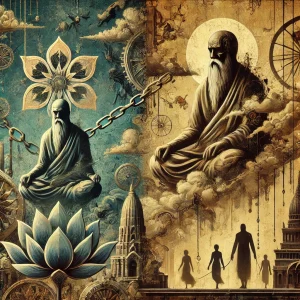
The colonial imposition of Judeo-Christian categories transformed Guru Nanak’s mystical, ontological lifestyle into a religion of belief and ritual. Through mistranslations, census, education, and law, terms like Ik Onkaar, Naam, Simran, Hukam, Shabad, Sangat, and Seva were redefined within Western theological frameworks. The result was a profound distortion: ontology was externalised into theology, remembrance was replaced by worship, deconstruction of ego was replaced by fixation on identity.
This represents not only epistemic violence but inversion of Guru Nanak’s vision. Where he taught Being, colonialism imposed belief. Where he dissolved haumai, colonialism reinforced it. Where he called for Simran, colonialism substituted prayer.
Decolonising meditation requires undoing these substitutions and returning to Guru Nanak’s ontology: Naam as resonance, Simran as attunement, Hukam as alignment, Shabad as vibration, Sangat as resonance field, Seva as ontological compassion. Only then can Gurmat be restored as the science of consciousness Guru Nanak gifted humanity.
- Gurmat Therapy as Decolonial Recovery
6.1 Decolonisation of Meditation
To decolonise meditation is to undo the epistemic violence of colonialism — the reduction of ontological Being into religious belief. It is to strip away imposed Judeo-Christian categories of God, prayer, worship, and command, and to restore the original vocabulary and practice of Guru Nanak.
- Naam must be recovered as resonance of Being, not “Name of God.”
- Simran must be recovered as ontological attunement, not “prayer.”
- Ik Onkaar must be recovered as one consciousness vibrating as all, not “One God.”
- Hukam must be recovered as alignment with presence, not “command.”
- Shabad must be recovered as vibration of consciousness, not “scripture.”
- Sangat must be recovered as resonance field of consciousness, not “congregation.”
- Seva must be recovered as ontological compassion, not “charity.”
This work of recovery is not nostalgic but revolutionary. It restores Guru Nanak’s teaching as science of consciousness — a living, experiential path that addresses mental, emotional, physical, and transpersonal health.
6.2 Gurmat Therapy as a Framework
Gurmat Therapy represents a structured, evidence-based way of embodying this decolonisation. It is not a “new invention” but a rearticulation of Guru Nanak’s ontology within contemporary psycho-spiritual and scientific language.
- Ontological Orientation: Gurmat Therapy begins from consciousness as primary reality (Ik Onkaar).
- Meditative Practice: Centrality of Simran as continuous remembrance, aligning attention (surat) with Naam.
- Psycho-Spiritual Health Model: Integration of mental, emotional, physical, and transpersonal health within Naam-alignment.
- Epistemology: Knowledge is not belief but direct experience (anubhav), guided by Shabad.
- Ethical Expression: Seva as natural flowering of ontological compassion.
- Collective Dimension: Sangat as resonance field generating coherence beyond the individual.
Thus, Gurmat Therapy is not religion, ritual, or identity, but a psychospiritual science of Being.
6.3 Evidence and Interdisciplinary Bridges 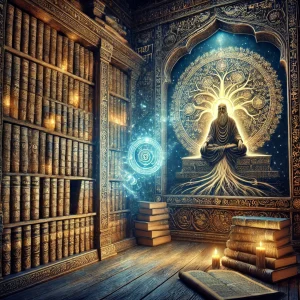
Modern science increasingly confirms what Gurbani revealed:
- Neuroscience: Simran and kirtan quiet the default mode network, dissolving ego chatter.
- Psychophysiology: Chanting and remembrance increase vagal tone, reduce stress, and regulate the autonomic nervous system.
- Heart–Brain Coherence: Simran synchronises heart rhythms with brainwaves, creating measurable coherence.
- Epigenetics: Meditation alters gene expression, reducing inflammation and improving resilience.
- Biophysics: Cells emit bio-photons — light at the core of life — echoing Gurbani’s imagery of inner light (jot).
- Quantum Consciousness: Concepts of entanglement and non-locality resonate with Naam as all-pervasive vibration.
These findings demonstrate that meditation in Gurmat is not superstition but measurable science — a consciousness-based paradigm that heals body, mind, and society.
6.4 Healing from Colonial Trauma
Colonial distortions created fragmentation: Sikhs taught to believe in doctrines rather than live Being, to cling to identity rather than dissolve haumai, to perform rituals rather than embody Simran. Gurmat Therapy addresses this trauma by reorienting practitioners to ontology.
Healing occurs when:
- Egoic fixation on identity is loosened.
- Simran restores resonance in consciousness.
- Sangat generates collective coherence.
- Seva re-integrates Being into action.
In this way, Gurmat Therapy is both individual healing (anxiety, trauma, fragmentation) and collective decolonisation (restoring ontology against reductionist categories).
6.5 Global Relevance 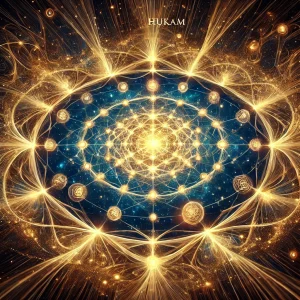
The recovery of Gurmat as a science of consciousness is not only for Sikhs but for humanity. In an age of ecological collapse, psychological crisis, and spiritual confusion, Guru Nanak’s ontology offers:
- A non-dual science of Being, beyond religious conflict.
- A psychospiritual health model integrating mind, body, and soul.
- A path of collective coherence through Sangat.
- A paradigm of compassion through Seva.
- A way of dying well, as Naam dissolves fear of death.
This global relevance positions Gurmat Therapy not as sectarian but as planetary medicine — a bridge between mysticism and science, East and West, ontology and evidence.
6.6 Conclusion: Returning to Being
Colonialism distorted Guru Nanak’s teaching, reducing ontology into theology, remembrance into prayer, presence into belief, deconstruction of ego into imposition of identity. The result was cognitive colonisation, shaping Sikh consciousness into categories alien to Gurbani.
The task now is decolonisation: to return from belief to Being, from identity to presence, from prayer to Simran, from scripture to Shabad, from command to Hukam, from religion to ontology.
Gurmat Therapy represents this return. It restores meditation as the medicine of Naam, grounded in consciousness itself, validated by modern science, and lived as daily practice. It is not escape but transformation, not belief but Being.
As Guru Nanak declared in Japji Sahib:
“ਮੰਨੈ ਸਗਲ ਭਵਣ ਕੀ ਸੁਧਿ ॥”
Mannai sagal bhavaṇ kī suḏẖ.
“By attunement, one comes to know all realms.” (SGGS Ang 3)
Attunement — this is Simran, the essence of meditation. To decolonise meditation is to attune once more to Naam, to dissolve haumai, to align with Hukam, and to live as Gurmukh.
Guru Nanak did not give humanity a religion; he gave a science of consciousness. Decolonisation is the work of remembering this truth
© 2025 D S Panesar
Gurmat Psychology Series
